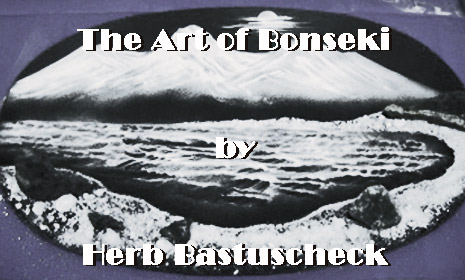Herb Bastuscheck and I first met online at Bob’s Rock Shop. At that time he was
living in Japan and teaching conversational English to Japanese students ages
three to seventy-nine. In July, 2004 we finally met in person in Karnes County,
Texas, where we gathered for a collecting outing along with my husband Tim, Larry
McAuley from Leander, Texas, and Virgil Richards from Broken Arrow, Oklahoma.
At the end of our wonderful day collecting fossils, fossil wood, and a few mineral
specimens, we met at Larry’s home where Elisa, Larry’s wife, and Regina, Virgil’s
wife, had prepared a delicious meal of marinated smoked burgers and other goodies
for us to enjoy. After dinner Herb set up his bonseki materials and demonstrated that
ancient Japanese art.
Bonseki is the art of creating a landscape on a black rectangular or oval lacquer tray
using white sand, pebbles, and small rocks. Bon means “tray” and seki means “rock,” so bonseki translates as “tray with
rocks.” It was developed at the Ryuanji Temple in Kyoto with the samurai Hosokawa family. Bonseki is similar to the tea
ceremony, where meditation accompanies a learned pattern of actions. Finished bonseki trays were placed in the little
alcoves below the hanging scrolls in family tea ceremony rooms. When the art form was developed 600 to 800 years
ago, it was much more stylized than it is today. About 100 years ago, bonseki artists went to Europe to study art, and
upon their return to Japan, they influenced the creation of photo-like pictures. Today colored rocks, fossils, and miniature
structures such as bridgesand temples are sometimes added.
Herb creates these sand paintings using small tools such as swan feathers, small spoons, and sieves that are ceremonially
placed about his workspace. The typical boneski landscape contains features such as Mt Fuji, rivers, lakes,
mountains, or waterfalls. A scene may take two hours or more to create, while a quick demonstration takes as little
as twenty minutes.
The art form is learned in increments by mastering individual features such as a river or a mountain. When one topic is mastered,
the artists move on to another topic. Eventually the artist will begin to combine subjects to create complete landscapes. These
artists will then just wipe the sand away,destroying the scene with a brush of thehand. Occasionally powdered glue may be
added to the sand and set with steam to createa more permanent display although this generally is not the norm.
Herb’s sensei, 92-year-old Masa Saito, has practiced the art for 50 years and has obtained the highest ranking—a gold embroidered
crest on a yellow tray scarf. Herb, the only non-Japanese bonseki master, reached his Rank of a gold embroidered crest on a purple
tray scarf after 12 years of weekly lessons.
Unfortunately, bonseki is a dying art form. Younger folks are not inclined to commit to the amount of time it takes to learn
this ancient art. Most of the active members are over 50, and many are in their 70s or 80s. Less than 10 percent are in
their 20s to 40s. Herb considers it an honor to be able to show an art form that so few folks have heard of. He tells
me that in all the time he spent in Japan, he only met two Japanese who knew what it was!
Herb and his wife, Sachiko are retired and now reside in Oregon where he is actively involved in collecting rocks,
minerals, and fossils, and in teaching earth sciences through a school show and tell program.
